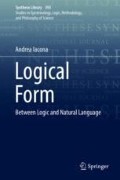Abstract
This chapter develops the analysis of quantified sentences sketched in Chap. 8. First, it draws a distinction between two senses in which a quantifier expression can be said to be vague, and outlines an account of the distinction that rests on independently grounded assumptions. Then it shows how the difference between the two senses can be represented at the formal level, and it addresses some debated issues concerning quantification. Although the claims that will be made have only a tangential bearing on the main theme of the book, some of them may be regarded as interesting in themselves.
Access this chapter
Tax calculation will be finalised at checkout
Purchases are for personal use only
Notes
- 1.
- 2.
The examples (7) and (8) are discussed in Peters and Westerståhl (2006), pp. 213.
- 3.
- 4.
- 5.
Here it is assumed that contextual restrictions are formally represented in the way suggested in Sect. 8.3. But note that we would get the same result if we adopted a formal representation in which a separate predicate letter expresses the restricting condition, since in that case (11) and (12) would be replaced by two formulas ∀x(Qx ⊃ (Px ⊃ Rx)) and ∀x(Sx ⊃ (Px ⊃ Rx)) which differ in the first predicate letter.
- 6.
Note that the converse entailment clearly does not hold, for it may be the case that the sentences containing a quantifier expression e (as used on a given occasion) admit nonminimal variation in formal representation even if e does not exhibit quantifier indeterminacy. This is shown by the case of ‘more than half of’, which does not exhibit quantifier indeterminacy even though (3) may be represented as (13) or (14).
- 7.
- 8.
Note that, given the restriction mentioned in Sect. 8.2, ‘sentence’ refers to simple quantified sentences such as (1)–(6).
- 9.
There is an interesting convergence between the account of logical quantifier expressions suggested here and the independently motivated account outlined in Feferman (2015), see p. 140. As is noticed in that work, pp. 144–145, it is not as obvious as it might seem that the converse of Theorem 9.4.1 holds.
- 10.
Moss (2008), section 8.2, provides a complete axiomatization of a class of inferences involving sentences containing either ‘most’ or ‘some’. The explanation suggested here seems to hold at least for that class.
- 11.
- 12.
Peters and Westerståhl, among others, assume that domains are sets, see p. 48. In Sect. 8.4 the same assumption is adopted for the sake of argument.
- 13.
- 14.
- 15.
Note, however, that it might be unclear whether ‘all’ is used unrestrictedly, in which case a similar kind of indeterminacy would arise. Note also that, just like ‘all’ may involve a restriction, the same goes for the general term ‘thing’ as it occurs in ‘all things’. As Lopez de Sa (2006), pp. 405–406, makes clear, (UP) is compatible with recognizing that there might be restricted uses of ‘thing’ that are vague. In that case, quantifying over every thing in that sense is not the same thing as quantifying over absolutely everything.
References
Barwise, J., & Cooper, R. (1981). Generalized quantifiers and natural language. Linguistics and Philosophy, 4, 159–219.
Bonnay, D., & Westerståhl, D. (2012). Consequence mining: Constants versus consequence relations. Journal of Philosophical Logic, 41, 671–709.
Feferman, S. (2015). Which quantifiers are logical? A combined semantical and inferential criterion. In A. Torza (Ed.), Quantifiers, quantifiers, and quantifiers. Cham: Springer.
Glanzberg, M. (2004). Quantification and Realism. Philosophy and Phenomenological Research, 69, 541–72.
Keenan, E. L., & Stavi, J. (1986). A semantic characterization of natural language determiners. Linguistics and Philosophy, 9, 253–326.
Lappin, S. (2000). An intensional parametric semantics for vague quantifiers. Linguistics and Philosophy, 23, 599–620.
Lepore, E., & Ludwig, K. (2002). What is logical form? In G. Preyer & G. Peter (Eds.), Logical form and language (pp. 54–90). Oxford: Oxford University Press.
Lewis, D. (1986). On the plurality of worlds. Oxford: Blackwell.
Liebesman, D., & Eklund, M. (2007). Sider on existence. Noûs, 41, 519–528.
López De Sa, D. (2006). Is ‘Everything’ precise? Dialectica, 60, 397–409.
Moss, L. S. (2008). Completeness theorems for syllogistic fragments. In F. Hamm & S. Kepser (Eds.), Logics for linguistic structures (pp. 143–173). Berlin/New York: Mouton de Gruyter.
Peters, S., & Westerståhl, D. (2006). Quantifiers in language and logic. Oxford: Oxford University Press.
Sider, T. (2001). Four dimensionalism. Oxford: Clarendon Press.
Sider, T. (2003). Against vague existence. Philosophical Studies, 114, 135–146.
Sider, T. (2009). Against vague and unnatural existence: Reply to Liebesman and Eklund. Noûs, 43, 557–567.
Torza, A. (2014). Vague existence. In Bennett K. y Zimmerman D. (eds.), Oxford Studies in Metaphysics, 10, 201–33.
Westerståhl, D. (1985b). Logical constants in quantifier languages. Linguistics and Philosophy, 8, 387–413.
Williamson, T. (2003). Everything. Philosophical Perspectives, 17, 415–465.
Author information
Authors and Affiliations
Rights and permissions
Copyright information
© 2018 Springer International Publishing AG
About this chapter
Cite this chapter
Iacona, A. (2018). Further Issues Concerning Quantification. In: Logical Form. Synthese Library, vol 393. Springer, Cham. https://doi.org/10.1007/978-3-319-74154-3_9
Download citation
DOI: https://doi.org/10.1007/978-3-319-74154-3_9
Published:
Publisher Name: Springer, Cham
Print ISBN: 978-3-319-74153-6
Online ISBN: 978-3-319-74154-3
eBook Packages: Religion and PhilosophyPhilosophy and Religion (R0)

